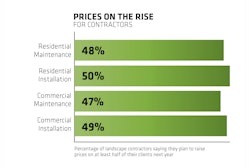You can't retain clients long-term by lowering your prices down to the level of the lowballers. If you attempt this route, you will have to reduce your level of customer service so low that you will lose the customers who bought you for your service. You'll compromise your ability to react to your better customers, and you will lose all ability to be a “proactive” service provider.
Of course, you do have to be flexible with your service offerings and pricing in many instances. Here are some tips from consultant Jeffrey Scott on how to do that without diminishing value in the eyes of the consumer.
Landscape Maintenance
Paring down services. The thing to keep in mind is that the client's property may not look as good in a year or two. "You have to manage that expectation," Scott points out. "Make it clear what's being cut—and that you'll have to re-address it in a year or two." It's good to convey these things in writing. Taking before-and-after photos of the property is also helpful in convincing the client to add that service back in down the road.
Have conversations on what is most important on their property. What you personally think should be cut isn't as important as what the client thinks. For example, some clients might be OK with you just taking care of the front but not the back. "Every client has a different values system," Scott reminds.
Have conversations on what is most important to them personally. The more you understand a client's personal values system, the more they are going to like you. Initiate conversations about:
- Family – What do you like to do around the property? Do you have kids who like to play soccer in the backyard? When do they play in the yard? How else do they use the yard? "The point is to figure out what's important to the family so you can better integrate what you do," Scott says.
- Upcoming events – Do you have any big parties or special events planned? What can we do to better prepare you for this event?
- Pet peeves – Again, you never know what a client's values system is. "I once had a client who loved a particular plant but hated the flower," Scott relates. "She asked us to deadhead the flower. We would've never thought of that on our own. It took having in-depth conversations with her to come to that conclusion."
Through all of this, it's useful to consider The 5 Whys method of asking questions. In short, you must ask "why" at least five times to ultimately get to the root of a problem. "You must have this deeper conversation that unwraps what the client's real needs are," Scott says.
Give them more, not less. It might be hard to imagine these days, but often in landscape maintenance the client wants you to give them more than what they're getting. They may be complaining about price, but really they are unhappy about the level of service they are getting for the price, or because you are forcing them to use multiple contractors to get all of their needs attended to. Being too narrowly focused can lead to lost clients.
Treat it like you would treat your own property. Walk properties proactively, with and without clients present. Provide updates and recommendations. Helping clients avoid costly problems in today's busy world is very important. "People often switch to a lowballer because their contractor isn't giving them what they were promised or what they want," Scott says. "If that's the case, you can't really blame the client for switching."
Do small things for free. "I'm a big believer that clients don't mind paying bigger bills as much as they mind having to pay small bills," Scott says. "In other words, they don't want to be nickel and dimed." Doing a few little things for free, and letting the client know, leaves a warm and fuzzy feeling with the client that can go a long way.
Design and Installation
Understand pricing issues before taking on a client. You never want to chase bad leads, so qualify them before paying them a visit. Chasing bad leads is bad for two reasons: 1) it wastes your time, and 2) it can undermine your confidence. "If you're trying to sell yourself to someone who is shopping on price, you might end up under-selling yourself to clients who are less concerned about price," Scott says.
Understand their goals, wants and desires. The 5 Whys method comes into play here. What in the client's personal life is driving them to invest in landscaping? For example, if a homeowner is soliciting bids on putting in a hedgerow separating them from their neighbors, you have to find out why they are doing this. Are they putting in landscaping to create a private oasis, or to block out a nuisance neighbor, or because their spouse asked for it, or because they think it will make it easier to sell the home later on? It may be a combination of these reasons, but which is most important? Take the time to get to the root of their motivation, and you will do a better job of gaining and keeping the client.
Regarding this example, Contractor A who bid $3,000 on the hedgerow lost out to Contractor B who bid $23,000 by changing the specs and proposing a larger, more mature row of plantings. Contractor B uncovered the client's real needs (nuisance neighbors) and gave a more immediate and believable solution.
Offer pricing choices on materials and quantities. You never know where a client will want to spend more money and where they will want to spend less money. For instance, maybe they don't want to spend on trees but they will on hardscapes, or vice versa. You have to give them choices in terms of both materials and quantity.
Unique design can be cheaper—and better. "We built a pool for a client with a multi million-dollar house," Scott relates. "But the client didn't want to spend a lot of money on the patio around the pool; he simply didn't value the patio. So we designed a patio that interlaid large panels of grass. It looked more unique and attractive but cost less money than a traditional hardscape patio. This allowed us to keep costs down and our margins up."
Do small things for free. Just as we pointed out in the first section on maintenance, don't nickel and dime your clients. Find small things to do for free. Finally, don’t bill them for tiny change orders; they will be more likely to accept your larger change orders if you don't.











![U8kj71gt 720[1]](https://img.greenindustrypros.com/mindful/acbm/workspaces/default/uploads/2025/10/u8kj71gt-7201.8OyDyc124u.jpg?ar=16%3A9&auto=format%2Ccompress&fit=crop&h=135&q=70&w=240)







